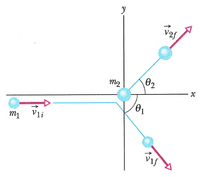Question
Sphere m1 with a mass of 1.0 kg collides with m2, which also has a mass of 1.0 kg, in an elastic collision. If v2f= 15 m/s and θ2= 40°, determine v1i. (Hint: An elastic collision requires that the after-collision angle between the two velocities must be 90°.)

Transcribed Image Text:v2f
m2
02
m1 Vli
vif
Expert Solution
This question has been solved!
Explore an expertly crafted, step-by-step solution for a thorough understanding of key concepts.
Step by stepSolved in 4 steps

Knowledge Booster
Similar questions
- A block with mass M = 5.60 kg is sliding in the positive x-direction at Vi = 8.00 m/s on a frictionless surface when it collides elastically in one dimension with a stationary block with mass m = 1.30 kg. Determine the velocities, Vf and vf, of the objects after the collision. Vf = ? vf = ?arrow_forwardThe drawing shows a collision between two small balls. Ball (1) has a mass of 140 g and is moving along the x-axis with a velocity of 4.60 m/s. It makes a collision with ball (2), which has a mass of 210 g and is initially at rest. After the 60°). What is the magnitude of %D collision, the two balls fly apart with angles as shown in the figure below (a = 58° and B the velocity of ball (2) after the collision? m/s +y m2 m1 +xarrow_forwardA bullet of mass 0.018 kg traveling horizontally at a high speed of 200 m/s embeds itself in a block of mass 4 kg that is sitting at rest on a nearly frictionless surface. (a) What is the speed of the block after the bullet embeds itself in the block? Vf = 7 X m/s (b) Calculate the total translational kinetic energy before and after the collision. Ktrans,/ = 180 X J Ktrans,f = 260 X J (c) Compare the two results and explain why there is a difference. O The Energy Principle isn't valid for an inelastic collision. The internal energy of the block-bullet system has increased. O Some of the momentum is lost in an inelastic collision.arrow_forward
- Two 1.9 kg bodies, A and B, collide. The velocities before the collision are v A= (14î + 34 j) m/s and v = (-15î + 9.0j) m/s. After the collision, v = (-7.oî + 16 j) m/s. (a) What is the final velocity of B? m/s (b) What is the change in the total kinetic energy (including sign)? 121.69 J The net external force on the two particle system is zero; thus, the net momentum of the system cannot change. The net momentum along the x axis before the collision must equal that after the collision. Same for the y axis. Use the definition of kinetic energy to find the total K before the collision and the total K after.arrow_forwardA block with mass M = 6.05 kg is sliding in the positive x-direction at Vi = 8.95 m/s on a frictionless surface when it collides elastically in one dimension with a stationary block with mass m = 1.30 kg. Determine the velocities, Vf and vf, of the objects after the collision. Vf = ? m/s vf = ? m/sarrow_forwardOne object is at rest, and another is moving. The two collide in a one-dimensional, completely inelastic collision. In other words, they stick together after the collision and move off with a common velocity. Momentum is conserved. The speed of the object that is moving initially is 21 m/s. The masses of the two objects are 2.7 and 7.8 kg. Determine the final speed of the two-object system after the collision for the case (a) when the large-mass object is the one moving initially and the case (b) when the small-mass object is the one moving initially. (a) vf = (b) vf =arrow_forward
- The sphere of mass m1 = 5 kg falls from a height H = 1.4 m onto the homogeneous board of negligible mass. The board can rotate around a horizontal axis passing through point O, and a body of mass m2 = 3.9 kg is placed on it at a distance b = 1 m from the axis of rotation. The collision is perfectly inelastic. How high does the body of mass m2 rise after the collision (in m) if a = 0.5 m?arrow_forwardConsider two objects on a collision course. Object 1 has a mass of (35 kg) and is initially moving with a velocity of (3 m/s ˆx). Object 2 has a mass of (22 kg) and is initially moving with a velocity of (5 m/s -ˆx).a) If the objects collide inelastically and stick together, what is their post-collision speed?b) If the collision occurs over a time of (0.05 s), what is the force that the objects experienced?c) If the objects instead collided elastically, what is the final speed of each object?arrow_forward
arrow_back_ios
arrow_forward_ios